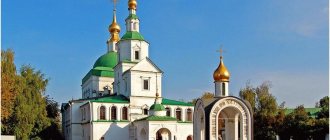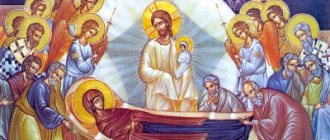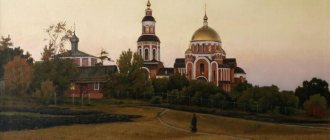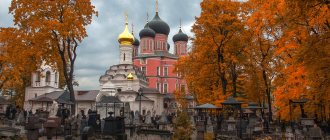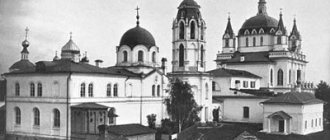The Conception Monastery in Moscow, the address of which is known to any resident of the Mother See, is the first and therefore the most ancient convent in the capital. We know exactly the date of its foundation - 1360. However, one should not think that before this time there were no women’s monasteries. By the way, the founder of the first convent was Prince Yaroslav the Wise himself. And the first, perhaps the most famous nun, was his granddaughter Princess Anna or, as she was called then, Yanka. It’s just that in those days, women’s monasteries did not have independence and were an integral part of men’s monasteries.
On the origin of convents
Monasteries in the church have existed since ancient times and came to us in Rus' with the adoption of Christianity. Initially, men's monasteries developed. Women's ones appeared a little later. Metropolitan Alexy of Moscow, at the request of his sisters, blessed them to organize an independent and independent convent. One of the sisters became the first abbess of this monastery. From that moment on, male and female monasteries always existed separately from each other.
The Conception Monastery is located in Moscow. The address of the monastery is 2nd Zachatievsky Lane, no. 2. This is the very center of the capital. This is not only the first convent in Moscow, but also a model for the emerging convents of the Mother See.
Information for visitors
The Conception Monastery is located between the Kropotkinskaya and Park Kultury metro stations. If you go by car, it is better on weekends - you can park in the side streets nearby; On weekdays everything here is occupied by vehicles.
- Monastery website: zachatevmon.ru
- Address: 119034, Russia, Moscow, 2nd Zachatievsky lane, 2.
Formally, photographs can only be taken on the territory of the monastery and in churches with the blessing of the abbess. We didn’t know this, so we took photographs freely on the territory, but in the cathedral, when we asked whether it was possible to take photographs, we were forbidden; moreover, the guards watched carefully so that we did not sneak a photo (although how can you take photographs secretly with a huge SLR?). I didn’t notice any special restrictions on clothing - there were women in trousers, and mothers came in with strollers. Well, the rest is the usual rules of conduct in a monastery.
Rules for visitor access to the territory of the Conception Monastery
© Website “On the Roads of the Middle Way”, 2009-2021. Copying and reprinting of any materials and photographs from the site anashina.com in electronic publications and printed publications is prohibited.
Juliania and Eupraxia Zachatievsky
Venerable Juliania and Eupraxia of the Conception - these names came to us from the distant past, from the great 14th century. Despite the nobility and wealth, the presence of a huge number of servants and serfs, parents raised girls in love and Christian virtues - respect for people, respect for elders. Personal labor became the basis of the life of the future holy wives, and, of course, Orthodoxy became for them not just the faith of their ancestors, but their entire being. They lived and breathed the Orthodox faith. Their modesty and mercy were well known. Many grooms from noble families wanted to take them as wives, but the girls, even in adolescence, made a firm decision to go to a monastery and take monastic vows.
The nuns wanted to dedicate their monastery to the Monk Alexy, the man of God, the heavenly patron. The Moscow Metropolitan blessed such a godly deed of his sisters and even allocated land for the construction of a convent. And so, on a small plot of land, occupied at that time by forests and water meadows, the Conception Monastery was built in Moscow, the address of which is now known to every resident of the capital.
Historical background
Thanks to the efforts of Moscow Metropolitan Alexy, the Conception Monastery was built. At the request of the sisters who served with him, things moved forward in 1360. This institution is the very first convent of exemplary order, which was erected in Rus'. The Conception Monastery has always been famous for its strict observance of Orthodox canons and the piety of its nuns and nuns. Many residents of the capital nicknamed him Starodevichy, a name that remains with him to this day.
Since the first building was built of wooden beams, it could not survive the great fire in 1547. Most of the Orthodox monastery burned to the ground. Ivan the Terrible, the sovereign at that time, allocated additional land for the construction of a new church, but the serving parish did not abandon its deanship and gradually worked on restoring the buildings. Only in 1584, the monastery from the surviving community again grew into a revered temple thanks to the financial assistance of Emperor Fyodor Ioannovich, whose wife Irina Godunova suffered from infertility. In the hope of the birth of an heir, the couple will finance the construction of the most important architectural elements that filled the territory of the monastery.
The good deed in the form of a built temple yielded its result: after the consecration of the icon of the Mother of God, the holy monastery gave Irina Godunova a daughter. That is why today it is called the Conception Monastery.
This very pious establishment attracted the attention of representatives of a noble family, who, by virtue of their faith, renounced worldly goods and served God. A women's shelter for orphan girls was established in the monastery, who, growing up in the monasteries of the temple, continued to serve it even after reaching adulthood. Strictness and order always reigned within the walls of the Orthodox institution, which were the lot of the smart managers Juliana and Eupraxia.
In 1612, the holy monastery of the monastery suffered from the Polish invasions, and in 1812 - from the invasion of French troops.
Construction of the monastery
In 1360, the Moscow saint built a small wooden church in honor of the Monk Alexy at his own expense. Near the church, the Metropolitan set up monastic cells and the necessary monastic buildings. There was also a monastery cemetery here. And all this was surrounded by a common wooden fence. This is how the Conception Monastery came into being in Moscow, the address of which you already know. It also became the first women's cenobitic monastery with a very strict charter. Following the example of the monastery of St. Sergius of Radonezh, where they preached humility and obedience.
The monastic economy gradually grew, and donations to the holy monastery from people of all classes increased. Thus, the economic independence of the women's monastery was strengthened, taking care of numerous widows and orphans. The fame of the monastery also increased. Currently, the monastery is located next to the Park Kultury metro station, and is easy to find on the city map.
Schedule of services in the monastery
Today, the convent performs its most important function, being a measure of the Orthodox faith of modern society. Finally, after many years of misuse, the divine monastery has returned to a Christian parish that serves the benefit of people.
On the territory of the Conception Monastery, divine services are held daily, in each individual church at the same time: morning - from eight o'clock, evening - from five o'clock. Every believer can become one of the participants in the services.
During its existence, the Conception Convent has made happy more than one woman who wanted to become a mother despite all the difficulties.
Patronage of Princess Evdokia of Moscow
Grand Duchess Evdokia of Moscow, wife of Prince Dmitry Donskoy, was very friendly with the reverend sisters. Saint Alexy played a huge, if not the main role in the life of the grand ducal pious family - it was he who arranged their marriage, and then took care of the young people. Honoring the great elder, Princess Evdokia of Moscow patronized the monastery, making generous contributions and donating holy icons. On the night of May 3, old style, 1393, the joyful Easter chants were interrupted by the bell striking three times, announcing the death of the pious abbess. A year later, her pious sister also passed away. But with their death, the spiritual life of the monastery did not fade. The nuns of the monastery led the same strict ascetic life, combined with work and mercy. For another whole century, the monastery was a worthy example of Russian cenobitic monasticism.
Shrines[edit]
Icon of the Mother of God “Merciful”
Belt of the Blessed Virgin Mary
cross-crucifix with particles of the Blood of Christ, the tree of the Cross and the Holy Sepulcher
martyr icon St. George the Victorious
Vmch. Panteleimon with a particle of relics
icon of the Conception of St. right Anna
reliquaries with particles of the holy relics of the new martyrs and confessors of Russia, as well as those who shone forth in the feat of fasting and prayer, an apostolic reliquary, etc.
Particularly revered is the burial place of the founders of the monastery, Abbess Juliana and nun Eupraxia, Hieromartyr Vladimir of Moscow (Ambartsumov) - the special patron of the Conception Monastery, with which he is connected by ties of both spiritual and blood kinship, St. Alexy, Metropolitan of Moscow, etc.
In the Cathedral Church of the monastery there is an ark with a particle of the relics of the holy righteous Lazarus of the Four Days, for whom a prayer service with an akathist is served daily at 12.00.
Fire in Moscow
In the mid-16th century, the capital suffered a terrible fire that destroyed many buildings, including the Conception Monastery. It was so badly damaged that Ivan the Terrible abolished it. A new location was determined closer to the Kremlin. However, several nuns continued to live on the ashes. They were confident that their monastery would definitely be reborn. The prayers were answered and the monastery was restored. This happened thanks to Prince Fyodor Ioannovich Godunov.
Story
The founding date of the religious institution is precisely known - 1360.
Despite the fact that the monastery is considered historically the first women's monastery, before that similar monasteries also existed, but in all cases only at men's monasteries. The monastery was founded by the Grand Duke of Kievan Rus, Yaroslav the Wise, and his first tonsured nun was the prince’s granddaughter, Anna (also known as Yanka). The construction of the wooden church building was carried out with the permission of the Metropolitan of Moscow, whose name was Alexy. And first the sisters settled in the monastery, their names were Abbess Juliania, nun Eupraxia. The construction was dedicated to the Monk Alexy, thanks to which the monastery later began to be called Alekseevskaya. It introduced and applied a special statute for the cohabitation of nuns.
A century later, in 1514, Vasily the Third ordered the architect Aleviz Fryazin from Italy to design a patronal cathedral dedicated to the Conception of St. on the site of the time-worn monastery. Anna.
In 1547, a misfortune happened and a big fire razed the Alekseevsky Monastery to the ground.
Then Ivan the Terrible ordered the burned nunnery to be moved to other lands - to Chertolye. Here it was successfully erected and operated until the 19th century. Today, on a historical plot of land under the burnt Alekseevsky Monastery, the Cathedral of Christ the Savior rises. But in those tragic years, some nuns did not leave their old place of worship and remained to live in the burnt building and stubbornly pray for its revival. The monastery was restored and began to be called the Conception Monastery.
Even in those distant times, people in this monastery began to ask God mainly for the birth of children.
In 1584, by decree of Fyodor Ioannovich Godunov, construction and restoration of the monastery began on the old site. Then the Cathedral of the Conception of St. Anne was built from stone and with it a church dedicated to the birth of the Blessed Virgin Mary.
However, troubled times again led to the loss of the monastery, which was soon rebuilt. In 1696, with the financial support of the steward A.L. Rimsky-Korsakov built the Church of the Savior of the Image Not Made by Hands. Its architectural style was dominated by Baroque. And since the steward was the owner of all the surrounding lands, the Spasskaya Church was his home church and received parishioners.
From 1766 to 1768 near the stone tent, on the graves of the women who founded the monastery (who were greatly revered and remembered by believers), a small temple was erected, named after the icon of the Mother of God. A century later, it was qualitatively rebuilt and greatly expanded, and the church became part of the complex of the Cathedral of the Nativity of the Virgin.
After 40 years, the monastery became very dilapidated, and it was dismantled down to the foundation. By 1807, on this site, the majestic Cathedral of the Nativity of the Virgin Mary had grown, and with it a monastery. The building of the latter was consecrated in 1813. The architects, the Kazakov brothers, gave it a neo-Gothic style (according to documents, the authorship of the architects has not been confirmed to this day).
The Patriotic War of 1812 began, by the end of which the monastery was completely destroyed. But by the power of believing people it was restored again. By 1850, an almshouse was built at the monastery, and the Church of the Descent of the Holy Spirit was also erected nearby.
Soviet years
In 1918, the Soviet government issued a decree on the nationalization of church lands and property. The confiscation of church valuables began. To protect the shrines and charitable institution of the monastery, Abbess Maria founded a brotherhood in the name of the Queen of Heaven under the patronage of His Holiness Patriarch Tikhon of Russia. After the monastery was closed, many nuns were sent by convoy to Siberia. Some were simply evicted without being given a place to live.
In the 90s, the revival of the monastery began. They began to return the shrines of the Conception Monastery in Moscow. In June 2008, a decision was made on church-wide veneration of the Venerable Sisters Juliania and Eupraxia. Work to restore the monastery continues to this day. Divine services are held in the recreated cathedral church, and every day prayers are offered to the reverend sisters.
Shrines of the monastery
This ancient monastery is the repository of several shrines. Every Orthodox Christian can bow to them and ask for help. The most revered shrine of the monastery is the “Merciful” icon of the Ever-Virgin Mary. Besides it, there are other shrines in the monastery. These are arks with the relics of the Holy New Martyrs and St. Lazarus. Also among the shrines there are pieces of the Holy Cross, the Holy Sepulcher, as well as a piece of the relics of St. Panteleimon. Among the shrines of the monastery are the burial places of the nuns - the founders of the monastery.
Belt of the Blessed Virgin Mary
Ark with exact copies of three particles of the Honest Gifts of the Magi
"Apostolic" reliquary
Icons
In the Cathedral of the Nativity of the Virgin Mary there is an ancient miraculous image of the Ever-Virgin Mary “Merciful”. Many miracles of healing occurred at this holy image. Orthodox Christians pray to this icon in difficult life circumstances, during depression, and ask for conception.
Temples
The main one is the Cathedral of the Nativity of the Virgin Mary. Its construction dates back to the beginning of the 19th century. The architectural style of this cathedral is called neo-Gothic. After its construction, the cathedral was destroyed several times. Now in its place stands a new majestic cathedral, founded in 2005 and consecrated in 2010. At the very end of the 17th century, the Gate Church was erected with the money of Rimsky-Korsakov, one of the nobles of Emperor Peter I. Already during Soviet rule, the temple was included in the list of monuments of Russian architecture.
The monastery also has a small church, built in the Byzantine style and consecrated in honor of the Descent of the Holy Spirit. A little later, a refectory chamber was built in the holy monastery. There are also several workshops for handicrafts.
Cathedral of the Nativity of the Blessed Virgin Mary in the Conception Monastery
How to get to the Conception Monastery in Moscow
The Conception Monastery is a famous place for pilgrims and tourists from different cities. People come here to pray, seek help from Saints Juliania and Eupraxia, and make a donation to the church. Zachatievsky Lane is the central street of Moscow. This is where the nuns' monastery is located. This is where both believers and just tourists come. Finding a monastery in the capital is very easy - get off at the Park Kultury metro station, walk along the street. Ostozhenka towards the Cathedral of Christ the Savior and turn right. At the end of the lane the monastery itself will be visible.
Miracles happening in the monastery
The most important miracles that happen in the Conception Monastery are the deliverance from infertility of many married couples who turned to the shrines of this monastery for help. Also, many believers were convinced of the healing properties of the relics regarding not only childbirth, but also deliverance from many other ailments.
The basis for miracles of healing, of course, is a strong faith in the help of God and all his holy faces. Famous throughout the entire district for its properties, the Conception Convent continues to amaze many with its miracles today.

